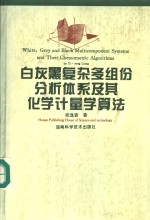

白灰黑复杂多组份分析体系及其化学计量学算法PDF电子书下载
- 电子书积分:11 积分如何计算积分?
- 作 者:梁逸曾著
- 出 版 社:长沙:湖南科学技术出版社
- 出版年份:1996
- ISBN:7535717314
- 页数:257 页
关于本书符号的说明 (Notation) 1
第一章 概论 (Introduction) 1
1-1 现代分析化学面临的机遇与挑战 (Opportunity and Challenge Faced by Modern Analytical Chemistry) 1
1-2 仪器分析与复杂多组份体系 (Instrumental Analysis and Complex Multicomponent Systems) 2
1-3 分析化学计量学与多元校正和分辨 (Analytical Chemometrics and Multivariate Calibration and Resolution) 5
1-4 本书各章内容简介 (Brief Description of Content for Each Chapter) 9
第二章 白色分析体系的多元校正方法 (Multivariate Calibration Methods for White Analytical Systems) 12
2-1 直接校正方法 (Direct Calibration Methods) 12
2-1-1 多元线性回归方法 (Multiple Linear Regression) 13
2-1-2 Kalman滤波法 (Kalman Filtering) 20
2-1-3 加权最小二乘回归法 (Weighted Least Squares Regression) 23
2-2 间接校正方法 (Indirect Calibration) 26
2-2-1 K-矩阵法 (K-Matrix Method) 27
2-2-2 P-矩阵法 (P-Matrix Method) 28
2-2-3 主成分回归法 (Principal Component Regression) 29
2-2-4 偏最小二乘法 (Partial Least Squares) 32
2-3 通用标准加入法 (Generalized Standard Addition Method) 36
2-4 广义内标法 (Generalized Internal Reference Method) 38
2-5 稳健多元校正方法 (Robust Multivariate Calibration Method) 47
2-5-1 稳健回归方法 (Robust Regression Methods) 49
2-5-2 诊断方法 (Diagnostic Methods) 54
2-5-3 降维处理的稳健方法 (Robust Methods of Dimensional Reduction) 58
2-6 非线性体系的校正方法 (Non-linear Systems Calibration Methods) 60
2-7 病态体系和有偏估计方法 (Ill-conditioned System and Biased Estimating Methods) 69
2-8 多元校正的分析化学品质因数和可靠性分析 (Figures of Merit of Analytical Calibration) 74
第三章 灰色分析体系的多元校正方法 (Multivariate Calibration Methods for Grey Analytical Systems) 85
3-1 矢量校正方法 (Vectoral Calibration Methods) 85
3-1-1 投影算法和多元校正模型的检验 (Projection Algorithm and Testing of Multivariate Calibration Model) 86
3-1-2 标准加入迭化目标转换因子分析法 (Additional Iterative Target Transformation Factor Analysis) 89
3-1-3 自适应Kalman 滤波法 (Adaptive Kalman Filtering Metbods) 93
3-1-4 局部曲线拟合法 (Local Curve Fitting Methods) 97
3-2 矩阵校正方法 (Matrix Calibration Methods) 100
3-2-1 秩消失因子分析法 (Rank Annihilation Factor Analysis) 102
3-2-2 广义秩消失因子分析法 (Generalized Rank Annihilation Factor Analysis) 107
3-2-3 残差双线性分解法 (Residual Bilinearization) 114
3-2-4 约束背景双线性分解法 (Constrained Background Bilinearization) 117
第四章 黑色分析体系的多元分辨方法 (Mutivariate Resolution Methods for Black Analytical Sytems) 129
4-1 基于主成分分析的体系组份数确定方法 (Methods Based on PCA for Estimating Number of Chemical Components in System) 130
4-1-1 误差扰动下的协方差阵特征值变化限制 (Varying Limits of Eigenvalues of Covariance Matrix Under Error Disturbance) 132
4-1-2 因子分析的误差理论 (Error Theory on Factor Analysis) 133
4-1-3 主因子数确定几种方法 (Several Methods for Determing Number of Principal Factors) 138
4-2 矩阵分辨方法 (Matrix Resolution Methods) 141
4-2-1 自模式曲线分辨法 (Self-modeling Curve Resolution Method) 142
4-2-2 迭代目标转换因子分析法 (Iterative Target Transformation Factor Analysis) 165
4-2-3 渐进因子分析法及其相关方法 (Evolving Factor Analysis and Related Methods) 168
4-2-4 窗口因子分析法 (Window Factor Analysis) 174
4-2-5 直观推导式演进特征投影法 (Heuristic Evolving Latent Projections) 177
4-2-6 其他方法 (Other Methods ) 206
4-3 张量分辨方法 (Tensor Resolution Methods) 220
4-3-1 投影旋转因子分析法 (Projective Rotation Factor Analysis) 221
4-3-2 广义秩消失因子分析法 (Generalized Rank Annihilation Factor Analysis) 224
第五章 统计学和线性代数基础知识 (Nexessary Knowledge on Linear Algebra and Statistics) 239
5-1 必要的线性代数基础知识 (Necessary Knowledge on Linear Algebra) 240
5-1-1 矢量和矩阵 (Vector and Matrix) 240
5-2 必要的统计学基础知识 (Necessary Knowledge on Statistics) 253
5-2-1 随机变量及其分布 (Stochastic Variables and their Distributions) 253
5-2-2 随机变量的数值特征 ( Digital Features of Stochastiv Variables) 255
- 《计算机视觉系统设计及显著性算法研究》徐海波著 2019
- 《全局光照算法技术》(美)菲利普·特瑞(Philip Dutre)等著 2019
- 《RNA折叠结构预测算法与计算复杂性》刘振栋著 2019
- 《ROS机器人编程与SLAM算法解析指南》陶满礼 2020
- 《图解数据结构与算法》汪建 2020
- 《信息融合中估计算法的性能评估》毛艳慧著 2019
- 《基于群体智能优化算法的文本过滤关键技术研究》朱振方,刘培玉,尉永清著 2019
- 《电力营销计量专业试题汇编 计量检定》中国电力科学研究院组编 2017
- 《被算法操控的生活:重新定义精准广告、大数据和AI=OUTNUMBERED FROM FACEBOOK AND GOOGLE TO FAKE NEWS AND FILTER-BUBBL》(瑞典)大卫·萨普特(DavidSumpter) 2020
- 《海洋动力环境模拟数值算法及应用》王永学 2019
- 《东西晋演义 话说中华五千年》(明)杨尔曾著 2019
- 《半道拾遗》郭宪曾著 2016
- 《甲子魂归》杨希曾著 2012
- 《票据法概论》谢菊曾著 1930
- 《中国印谱全书》陈师曾著 2013
- 《我国新媒体产业的市场结构、行为与绩效研究》周曾著 2013
- 《中国绘画史》陈师曾著 2013
- 《中国亚非关系史》耿引曾著 2014
- 《中国文化艺术名著丛书 中国绘画史》陈师曾著 2013
- 《中国司法制度》陶汇曾著 1926
- 《钒产业技术及应用》高峰,彭清静,华骏主编 2019
- 《现代水泥技术发展与应用论文集》天津水泥工业设计研究院有限公司编 2019
- 《异质性条件下技术创新最优市场结构研究 以中国高技术产业为例》千慧雄 2019
- 《Prometheus技术秘笈》百里燊 2019
- 《中央财政支持提升专业服务产业发展能力项目水利工程专业课程建设成果 设施农业工程技术》赵英编 2018
- 《药剂学实验操作技术》刘芳,高森主编 2019
- 《林下养蜂技术》罗文华,黄勇,刘佳霖主编 2017
- 《脱硝运行技术1000问》朱国宇编 2019
- 《催化剂制备过程技术》韩勇责任编辑;(中国)张继光 2019
- 《信息系统安全技术管理策略 信息安全经济学视角》赵柳榕著 2020
